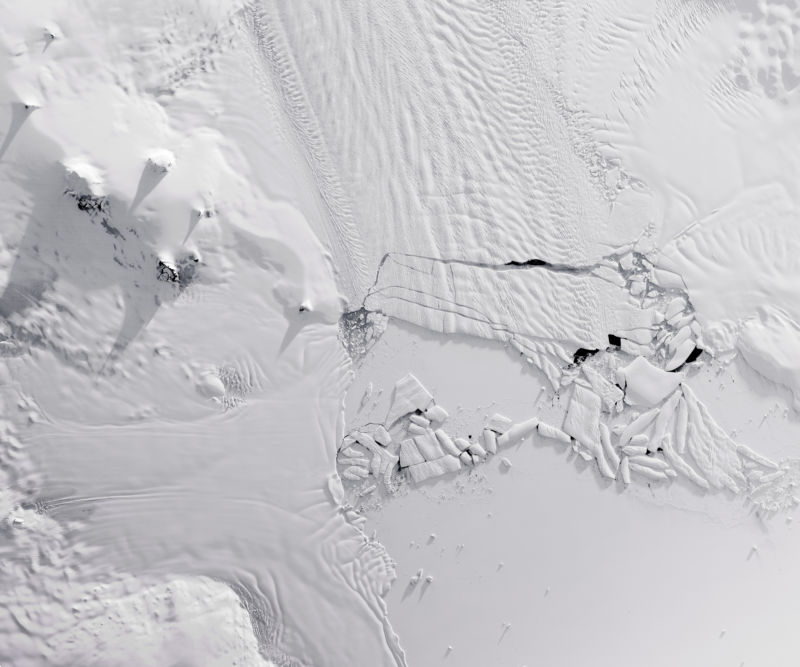
Imagine, if you will, the engineers of the king’s court after Humpty Dumpty’s disastrous fall. As panicked men apparently competed with horses for access to the site of the accident, perhaps the engineers were scoping out scenarios, looking for a better method of reassembling the poor fellow. But presumably none of those plans worked out, given the dark ending to that fairy tale.
A recent study published in Science Advances might be relatable for those fairy tale engineers. Published by Johannes Feldmann, Anders Levermann, and Matthias Mengel at the Potsdam Institute for Climate Impact Research, the study tackles a remarkable question: could we save vulnerable Antarctic glaciers with artificial snow?
Keeping our cool
Antarctica’s ice is divided into two separate ice sheets by a mountain range, with the smaller but much more vulnerable West Antarctic Ice Sheet representing one of the biggest wildcards for future sea level rise. In 2014, a study showed that two of the largest glaciers within that ice sheet—known as the Pine Island Glacier and Thwaites Glacier—had likely crossed a tipping point, guaranteeing a large amount of future ice loss that would continue even if global warming were halted today.
Much of the bedrock beneath the West Antarctic Ice Sheet is actually below sea level, though it’s buried below kilometers of solid ice. This makes for situations where the bed beneath the ice slopes down as you go inland from the coast. That’s inherently unstable, and once a glacier starts retreating downslope, the invading water provides an increasing floating force that reduces the sliding friction that slows the seaward flow of ice.
In the case of the Pine Island and Thwaites Glaciers, it seems that this is exactly what’s happening. Although this process can take centuries to fully play out, this portion of the ice sheet contains enough ice to raise global sea level by more than a meter.
Is there some extraordinary measure that could prevent that loss and preserve these glaciers? It’s the kind of question people will often ask, and scientists (who know the scale of these things) generally ignore as implausible.
But in this case, the researchers decided to go wild. Using a computer model of the ice sheet, they simulated the effects of adding huge amounts of ice near the front of these two glaciers. The idea works like this: Where a glacier meets the sea, it transitions from grounded to floating. Behind this “grounding line,” the glacier sits on the bedrock and sediment beneath; in front it gets thinner and floats as an ice shelf. To preserve the glacier, you need to keep that grounding line from retreating downhill. Thicken the ice on the inland side of the grounding line, and the thickness of ice flowing over the line and into the ice shelf increases—its weight keeps the grounding line pinned in place.

The researchers played around with different amounts of ice added to the glaciers for different periods of time, ranging from 10 year treatments to 50 years. Spreading it out over a longer period could mean a less preposterous addition of ice each year, but they found that the total amount has to increase if you do it that way. So in the end, the scenario they selected was 7,400 billion tons of ice added over 10 years. That was enough to restabilize these glaciers, preventing their inexorable decline.
Two for one special
To put that into context, removing that much seawater from the ocean would lower global sea level by about 2 millimeters per year. Current total sea level rise is a little over 3 millimeters per year, so it would be like nearly halting sea level rise… by bailing water out of the ocean. We can call that a bonus positive.
This analysis is more about what it would take than what such a scheme would look like, but the basic options are to pump water up and hose it around—hoping it freezes quickly—or to freeze it into snow like the world’s most awkwardly located ski resort.
Here, the researchers transition to listing all the reasons this is impractical and all the negative impacts it could have. For starters, the seawater would have to be desalinated since salt would probably affect the physics and behavior of the ice. Simply pumping that much water up the 640 meters and spreading it over an area nearly the size of West Virginia would require the power of something like 12,000 wind turbines—and that’s without the very substantial energy requirements for desalination and snow-making.
“The practical realization of elevating and distributing the ocean water would mean an unprecedented effort for humankind in one of the harshest environments of the planet,” the researchers write.
The impacts on Antarctic ecosystems could also be huge. Pumping that water out of the sea near the coast would significantly alter the circulation of water, which might even become somewhat self-defeating, as it could bring more warm water up against the ice shelf, increasing melt.
In the Potsdam Institute’s press release, Levermann puts it this way: “The apparent absurdity of the endeavour to let it snow in Antarctica to stop an ice instability reflects the breath-taking dimension of the sea-level problem. Yet as scientists we feel it is our duty to inform society about each and every potential option to counter the problems ahead.”
And to be clear, this is in addition to halting climate change—the scenario the numbers are based on assumes the temperatures don’t keep rising. But as the alternative is eventual inundation of parts of the world’s coastal cities, an argument can be made that the cost could be worth paying. It least it gives us an idea just how hard it would be to put Humpty Dumpty back together again.
Science Advances, 2019. DOI: 10.1126/sciadv.aaw4132 (About DOIs).
https://arstechnica.com/?p=1539237

